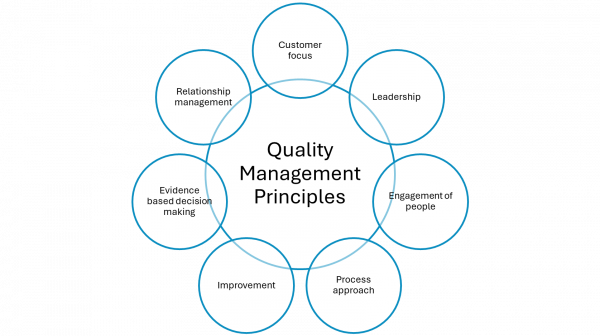The Need and Use of a Quality Management System

With a growing global market, companies continuously need to find ways to stand out from the masses. One aspect that customers find important is quality, it is among the top three reasons for purchases (Haas, McGuire Christian, & Keuky, 2022). But what is quality? Caramela (2025) suggest that the main aspect is trust, trust in that the product or service will fulfill the customer’s needs and expectations.
Quality management is considered to consist of four key parts: planning, improvement, control and assurance. Planning is to identify the standards of quality suitable for your organization. Improvement stands for continuously looking for new ways to improve your processes. Control is for checking the output of your processes while assurance is the more proactive version, meaning to identify potential hazards before they cause problems.
But quality management is not just about keeping to set standards within processes. It is also about upholding a standard of culture within the organization, ensuring that products and services satisfy the customer’s needs and to define success with a focus on customer satisfaction. (CFI, 2025)
Quality management follows seven principles as seen from the figure. The principles do not follow a set priority, it is up to each organization to identify what aspects, if any, are more important. These principles are a fundamental part of any QMS and are something that companies should focus on to be able to stay relevant in a continuously changing market.

What else are QMS based upon? A theory that works as a foundation for many QMS, the most popular being the ISO 9001:2015 standard, is the PDCA cycle. PDCA stands for plan, do, check and act (Naydenov, 2024). Simply put, you first need to make a plan for the changes you want to make. Once you have a plan, you need to implement the changes and check their performance. After checking the performance by gathering relevant data, you need to act on the data and make changes as needed, thus continuing the cycle.
Another theory, or maybe more of a mindset, that is part of QMS is the Zero Defects program developed by Philip Crosby. The basic principle of this theory is to do the process right the first time (Simplilearn, 2024). This theory focuses on eliminating waste from the processes, such as defect products, and thus saving the company both money and resources. As a natural result of eliminating defects, the customers will get a more coherent experience of the company and hopefully then also perceive the quality as being of a higher level.
But how do you identify what changes need to be made? Here Juran suggests organizations use the Pareto principle, also known as the 80/20 rule. Juran was the first to implement this rule in a quality management setting, it was already a well-established rule within the mathematical field. The 80/20 rule states that 80% of the results come from 20% of the process (Hardy, 2010; Juran, 2019). This means that 80% of the defects can be traced down to 20% of the process, therefore, the 20% is what should be focused on since it is what will make the greatest impact on quality. You could also try doing a root cause analysis, also known as the Five Why’s. This analysis is done simply by asking the question “why” as many times as needed until you get to the root cause of the problem. Think of it as a toddler bombarding with “why” until they are satisfied with the answer.
Studies also suggest that another benefit of following a well-structured QMS is increased employee satisfaction (Rateb, Rawan, Sharaireh, & Moarefi, 2019). This is due to the focus on leadership training, structure and communication. It is commonly believed that leaders are born, but numerous studies have shown that they can be trained. Good leadership traits to focus on are communication, accountability, responsibility, long-term thinking, ability to motivate oneself and others, confidence, people-orientation and emotional stability (Wale, 2025).
So why does NCS want a QMS? The short answer would be the same reasons as listed above. A more in-depth answer would be that the ISO standard offers a well-structured and globally recognized QMS. With the implementation of ISO, NCS hope to gain competitive advantages by demonstrating their commitment to quality and the environment. NCS also hope to increase their reputation and efficiency by following the clear process structure offered by the ISO standard. Moreover, NCS also seek to increase their customer satisfaction while also ensuring their employees’ satisfaction and well-being.
The steps NCS has taken to achieve ISO certification are the detailed mapping of processes, leadership training, developing internal standards for documentation and focus on internal communication using newsletters, developing an intranet, regular breakfast online meetings amongst the different offices as well as monthly check-in meetings one-on-one with the employee and their team leader.
Biography
Johanna Skrifvars works as a transport planner at NCS as well as an ADR safety advisor at her family’s company. All transport-related questions are of interest and Johanna continuously seeks new ways to improve herself, both professionally and privately.
On her free time Johanna likes to spend time with her family and friends, often cooking them too much food. Time spend outside in the Finnish nature is also prioritized, even if it is just for a second to catch her breath before jumping on the next project.

References
American Society for Quality. (2024). WHAT IS ISO 9001:2015 – QUALITY MANAGEMENT SYSTEMS? Retrieved from ASQ.org: https://asq.org/quality-resources/iso-9001
Caramela, S. (2025, January 9). Elevating Expectations: 6 Ways Product Quality Affects Your Brand. Retrieved from Business.com: https://www.business.com/articles/5-reasons-why-product-quality-matters/
CFI. (2025). Quality Management. Retrieved from CFI: https://corporatefinanceinstitute.com/resources/management/quality-management/
Haas, A., McGuire Christian, M., & Keuky, R. (2022). 2022 Global Marketing Trends. Retrieved from Deloitte.com: https://www2.deloitte.com/content/dam/insights/articles/us164911_gmt_2022_master/DI_2022-Global-Marketing-Trends.pdf
Hardy, M. (2010, September). Pareto's Law. Mathematical Intelligencer, 32(3), 38-43.
Juran. (2019, March 12). Pareto Principle (80/20 Rule) & Pareto Analysis Guide. Retrieved from Juran.com: https://www.juran.com/blog/a-guide-to-the-pareto-principle-80-20-rule-pareto-analysis/
Naydenov, P. (2024). The PDCA Cycle: A Practical Approach to Problem-Solving. Retrieved from Businessmap: https://businessmap.io/lean-management/improvement/what-is-pdca-cycle
Rateb, S. J., Rawan, A. S., Sharaireh, Y., & Moarefi, A. (2019). An investigation of the satisfaction of project managers and team members. The International Journal of Quality & Reliability Management, 708-734.
Simplilearn. (2024, September 24). The Concept of Zero Defects in Quality Management. Retrieved from Simplilearn: https://www.simplilearn.com/concept-of-zero-defects-quality-management-article
Wale, H. (2025). Leadership Traits. Retrieved from CFI: https://corporatefinanceinstitute.com/resources/management/leadership-traits-list/
In this blog you'll read posts from students studying for Master of Business Administration, Digital Business and Management, MBA. The writers are responsible for the content and opinions in the blog text.
Digital Business and Management, MBA
Disclaimer: The author(s) are responsible for the facts, any possible omissions, and the accuracy of the content in the blog.The texts have undergone a review, however, the opinions expressed are those of the author and do not necessarily reflect the views of Novia University of Applied Sciences.
Posta din kommentar
Kommentarer
Inga har kommenterat på denna sida ännu